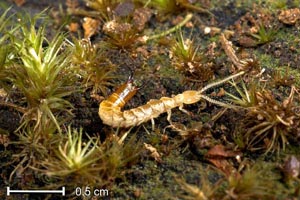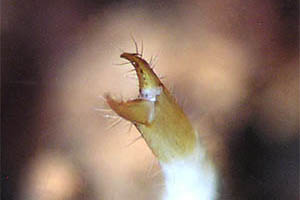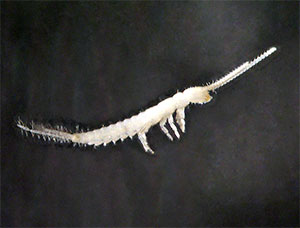|
Diplura
 Heterojapyx
Heterojapyx, a large japygid Diplura, New Zealand. Common name: diplurans, two-pronged bristletails.
Scientific name: phylum Arthropoda, class Diplura, from Greek “diplos”, two, and “ura”, tail — referring to two prominent abdominal cerci.
Description
Diplura are a group of primitive wingless hexapods, sometimes considered a part of Insecta. Diplura are cryptic animals, blind and colourless, usually 0.3-1.0 cm in length, although largest species can reach 3-5 cm.
The body of diplurans is elongate, and subdivided into a head, a thorax with three pairs of walking legs, and a long segmented abdomen. The head bears a pair of long antennae with bead-like segments. All Diplura are eyeless. The ten-segmented abdomen ends with a pair of prominent abdominal appendages – cerci, which gave Diplura their name.

The head of a dipluran.
|

The pincer-like cerci of a japygid Diplura.
|
Within Diplura, several body types exist:

Campodeid Diplura, side view.
In japygid diplurans (superfamily
Japygoidea) the abdominal cerci are modified into
a pair of pincers, which are hardened and darker in colour
than the whitish body. Japygid Diplura vary greatly in size,
and can be quite large, robust, and conspicuous. The elongated
body and pincer-like cerci of japygid Diplura may cause
them to be confused with earwigs (Insecta: Dermaptera).
Unlike earwigs, japygid Diplura are always eyeless, white
apart from darker sclerotized cerci, and have neither wings
nor elytra (small hardened wing covers).
Another type of dipluran are the campodeid
Diplura (superfamily Campodeoidea). Campodeid
Diplura are small, white in colour, and can be recognized
by long filamentous segmented abdominal cerci, which break
off easily. The third type are the species within superfamily
Projapygoidea, with shortened, thick, segmented cerci.
Notes on biology
Diplura possess chewing mouthparts and feed
on a variety of live prey and dead organic matter. Japygid
Diplura are mainly predatory and use their pincer-like cerci
to capture prey such as collembolans, soil isopods, small
myriapods, insects and their larvae, and even other diplurans.
They may also supplement their diet with fungal mycelia and
plant debris. Campodeid Diplura have been found to feed on
soil fungi, mites, collembolans, and other small soil invertebrates,
as well as detritus. Some dipluran species are herbivorous
and feed on plants and plant material.
The sexes are separate and, as in other
primitive wingless hexapods, fertilization is external. The
males produce packets of sperm (spermatophores) and randomly
deposit them on a substrate. In campodeid Diplura, the spermatophore
resembles a small globule, supported above the substrate by
a short stalk. Females pick up the spermatophores and use
them to fertilize their eggs, which they lay in small clusters
in soil cavities or crevices in the substrate. Female campodeid
Diplura abandon their eggs, but japygid Diplura are known
to remain in the brood chamber with the egg cluster, protecting
the eggs and the newborn larvae.
Development is direct, without metamorphosis.
The eggs hatch into young Diplura, which resemble adults apart
from smaller size, incomplete number of body setae, and the
lack of reproductive organs. The development is slow, through
a series of moults. Diplura continue to moult throughout their
life, slowly increasing in size, and over the course of several
moults are able to regenerate lost abdominal cerci, antennae,
and legs – a feature unique for hexapods. Their life
span is relatively short.
Where to find them?
In New Zealand Diplura are common inhabitants
of forests, parks, gardens, grasslands, and shrublands. Diplurans
can be found in the top layer of soil, in forest leaf litter,
under stones and logs and in rotting wood. In other parts
of the world, Diplura are often found in caves and have been
found in the nests of ants and termites. Although larger species
can be seen with a naked eye, smaller campodeid diplurans
are often too small and fragile to be noticed and/or caught
without damage. These Diplura are best collected using a Berlese
(Tullgren) funnel. Diplura can be preserved and stored in
75% alcohol.
Distribution and conservation
Diplura are distributed worldwide, from
the tropics to temperate zones. There are around 800 known
species, 11 of which occur in Great Britain and 70 in North
America. Diplurans are common inhabitants of soil and leaf
litter, and are a part of the soil community of decomposers
that help break down and recycle organic nutrients.
New Zealand Diplura are very poorly studied,
with little information available on their biodiversity, ecology,
or distribution. Diplura have no conservation status in New
Zealand, although large japygid Diplura are often protected
in other countries. A dipluran Plusiocampa fieldingi
(Campodeidae) has been placed on the list of rare species
by the state of Western Virginia, USA. Some dipluran species
pose an agricultural threat. For example, the dipluran Octostigma
herbivora (Projapygidae) has been listed as a potential
pest species by the New Zealand Ministry of Agriculture and
Forestry.
Included images:
- Family Heterojapygidae
- Heterojapyx sp. - Ohinetonga Scenic Reserve, TO, North Island
- Unidentified species - Wanganui National Park, WI, North Island
- Other
- Unidentified species - Wanganui National Park, WI, North Island
Further information on New Zealand
Diplura:
Ferguson, L.M. 1990. Insecta: Diplura. In:
Dindal D.L. (ed.). Soil Biology Guide. J. Wiley & Sons,
New York, p. 951-963.
Wise, K.A.J. 1977. A synonymic checklist
of the Hexapoda of the New Zealand sub-region. The smaller
orders. Bulletin of the Auckland Institute and Museum, No.
11, 176 pp.
Diplura Resources on the Web
Biodiversity
Explorer: Order Diplura, brief overview of Diplura biology.
Compendium
of Hexapoda Classes and Orders: Diplura, by John R. Meyer,
NC State University, includes information on classification,
life history and ecology, distribution, physical features,
economic importance, major families and links to other sites.
Biology,
Natural History and Ecology of Diplura, by Sharmeen Hossain,
University of Georgia, Athens, contains information on phylogeny,
distribution, identification, natural history, how to encounter
and links to other sites.
The
Tree of Life: Diplura, description of phylogenetic relationships
of Diplura and good source of references and links.
The
Diplurans (Diplura) of South Africa, compiled by Martin
H. Villet, Rhodes University, lists species of South African
Diplura.
Ecowatch:
Diplura, CSIRO, gives a brief description of the life
cycle, feeding and habitat of Australian Diplura.
Nomina
Insecta Nearctica: Diplura, a list of North American Diplura.
Order
Diplura - Two-pronged Bristletails, Kendall Bioresearch
Services, gives some information about Diplura of the British
Isles.
Gordon
Ramel’s Diplura Page, contains information on biology
and taxonomy of Diplura.
The
Orders and Selected Families of Insects: Diplura, by F.
W. Ravlin, Virginia Polytechnic Institute and State University,
a general fact sheet on Diplura.
|